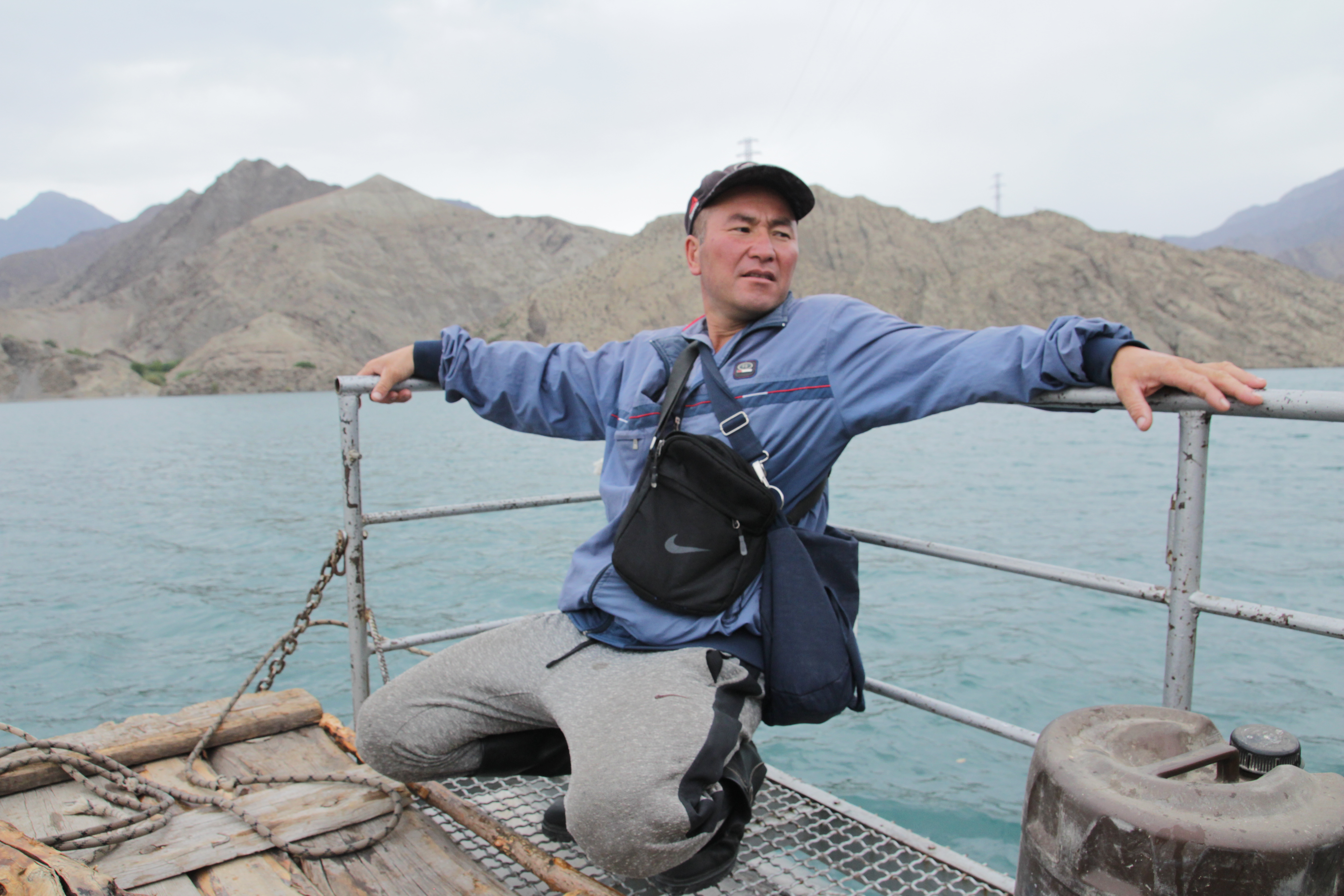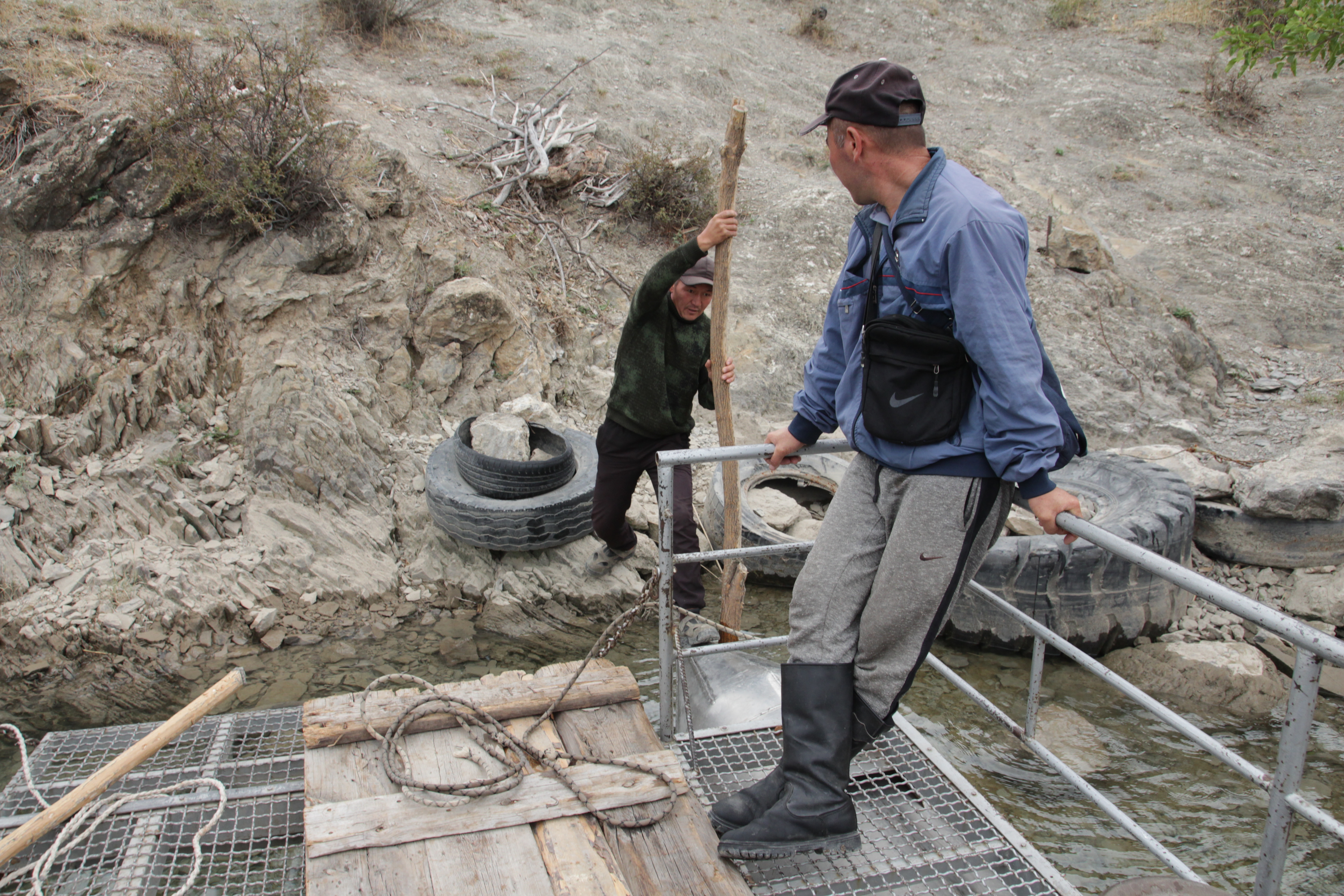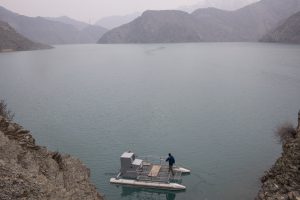When Kulchoro Ramanov took his Kyrgyz language exam, required for the members of Kyrgyzstan’s state administration, he left the examination board in a state of bewilderment. “I don’t know how to use a computer,” he told them. “In my village there is no electricity and never has been.” The board shook their heads, but made an exception. Ramanov was allowed to answer on paper. He passed with flying colors. Kyrgyz is the only language he knows.
Situated in Jalal-Abad province in south Kyrgyzstan, the village of Kyzyl-Beyit used to be well connected to the outside world. However, in the 1960s, the Kyrgyz Soviet Socialist Republic embarked on an ambitious hydropower project. On the Naryn River, which flows from the Tian Shan Mountains to the Syr Darya and then onward to the Aral Sea, the so-called Naryn hydropower cascade was built. The Toktogul, Kürpsay, Tash-Kömür, Shamaldy-Shay, and Üch-Korgon hydropower plants (HPPs) continue to supply the country with energy.
Driving the highway along the eastern side of the Kürspay reservoir, it is difficult to imagine that anyone lives in the rugged mountains on the opposite shore. But they do. A small self-made ferry takes passengers across the 800-meter-wide reservoir, created after the river was dammed up. After another 15 kilometers of winding uphill road, one reaches Kyzyl-Beyit, one of the most isolated villages in Kyrgyzstan.
43-year-old Ramanov is its head. He has no office, even the phone doesn’t always work. But Ramanov has more serious challenges to deal with.

Ramanov rides the small self-made ferry across the Kürspay reservoir. Photo by Emilia Sulek.
The Village
335 people live in Kyzyl-Beyit, comprising 66 families. Their houses look like the set of a period film. No new ones are being built, as building materials would have to be ferried in. The cars are well worn, too. Why buy new ones when there is nowhere to drive? The road to the village has not been maintained for years. It used to link up with the highway that runs from the capital Bishkek to the south of the country, but at one point the highway was flooded, taking with it the turn to Kyzyl-Beyit.
The Kürpsay HPP is only 5 kilometers from the village.
“It feels no closer than the moon,” Ramanov says. In the evening, his village plunges into darkness. Only the moon shines in the sky. Solar panels work only during good weather.
Much more threatening than the lack of electricity is the lack of healthcare. There is not a single nurse, let alone a doctor, in the village. In case of an emergency, one can try to get a telephone consultation, but in this rugged terrain the signal is often very weak, if it works at all. Pregnant women travel to a nearby town once they’ve reached eight months. Ramanov was born on the other side of the Naryn River. He was brought home by boat after the reservoir was filled in 1981.
“Our curse was that the Soviet Union collapsed. If not that, the authorities would have built what they promised: a bridge, a road, an electricity line,” Ramanov’s mother, Toktoyim Temirbekova, believes.
After Kyrgyzstan became independent in 1991, the country was engulfed in an economic crisis. Still, the families of Kyzyl-Beyit were offered land in Razan-Say, a village on the opposite side of the reservoir. But there was neither electricity nor running water there either, and the land was of much worse quality. Only three families decided to move.

The houses of Kyzyl-Beyit look like the set of a period film. Photo by Anush Babajanyan.
Cashmere and Walnuts
The picturesque mountains around Kyzyl-Beyit are covered with one of the largest wild walnut forests in Kyrgyzstan. In good years, villagers collect several hundred kilograms per household. “We survive thanks to walnuts and goats,” says Ramanov.
Goats from Kyzyl-Beyit are used for the popular Kyrgyz horse game kok-boru, inscribed on the UNESCO list of Intangible Cultural Heritage. Known in nearby Afghanistan as buzkashi, the game centers on horse riders fighting over the headless carcass of a goat. As the game is played all over Kyrgyzstan demand for goats is high. A large animal can cost $150. From their hundred goats, the Ramanovs can also collect some 50 kilograms of cashmere, which brings in around $1,600 a year. Poorer households rely on remittances from family members working abroad and material aid from the state.
People keep horses for transportation, but only a few, because fodder would have to be ferried in to support more. There is not enough grass to raise sheep. For cows, one has to bring in hay by ferry.
The woods around Kyzyl-Beyit also full of other species. Rowan tree, or Persian mountain ash (Sorbus persica Hedl.), is listed in Kyrgyzstan’s Red Book of endangered species. There are wild apple, pear and apricot trees, barberry and peanuts. Scholars from the Academy of Sciences started documenting the local flora. Ramanov invited them, hoping that it will help him solve his main problem: the nearby gold mine.
Gold
Gold was discovered in the vicinity of Kyzyl-Beyit in 1974. However, only in 1987 did serious geological mapping begin. Those efforts were interrupted by the collapse of the Soviet Union and Kyrgyzstan’s independence. In the 1990s, under the first president of independent Kyrgyzstan, Askar Akayev, a Chinese company received a license to continue the exploration work. For many years, nothing happened, and the license passed from company to company. Finally, in 2020, Oriel Gold LCC, another Chinese-owned company, arrived in the region.
“We were told that they’re only taking samples and sending them to China,” says Ramanov. But the villagers report that a processing plant has already been constructed in the mountains above Tokhtazan, a place where they used to graze their livestock.
The Tokhtazan deposit is not the largest gold deposit in Kyrgyzstan. That title belongs to Kumtor, one of the highest elevated open pit mines in the world, where over 300 tons of gold are said to have been depleted since 1996. Tokhtazan is believed to have at least 30 tons gold.
“We cannot prohibit them from mining, but we ask: please refrain from open pit mining. And do not process the ore here, but elsewhere, where it causes less environmental damage,” Ramanov pleads.
The villagers fear that cyanide used in processing gold will spill into the waters that people and their animals drink. In 2022, the Kyrgyz Ministry of Ecology promised that the ore would be processed at a facility in Karabalta, in northern Kyrgyzstan. But it doesn’t seem they will keep their word.
Taking the job of village head in 2015, Ramanov thought he would only have to deal with local issues. But Oriel Gold’s arrival pulled him into big politics.
“Dirty politics,” he stresses.
Invited to a meeting with the investor company in 2020, the villagers were asked to sign an attendance list. Ramanov says that the company took their signature and claimed later that the villagers had signed their agreement to the company’s operations.
When the ferry broke, the investor donated $4,500 to build a new one. The villagers collected the other half of the necessary funds. “Accepting this money is presented now as a sign of our good will,” Ramanov says as he shakes his head.
When Ramanov appealed to provincial and state authorities to revoke the company’s license or at least guarantee that damage to the environment will be minimized, he heard back: “You signed you agree.”
When he argued that he had evidence that the Chinese investor cut down several hectares of protected rowan trees, he was told: “In our documents they are not listed as endangered.”
The Chinese company says it would be willing to build a road or even an electricity line to the village.
“What’s the sense of such investments, if we’re soon going to drink polluted water?” Ramanov asks.
In Kyrgyz, Kyzyl-Beyit means “red cemetery.”
“Before we die, we would like to live a healthy life here.”
Ramanov hoped to talk to President Sadyr Japarov, who gained popularity as an opposition figure agitating against the mismanagement of the Kumtor gold mine in the 2010s.
But Japarov’s view of environmental activism has changed since he rose to power in 2020 and was elected president in January 2021. In 2022, a teenage blogger was arrested after questioning the legality of the government’s plans to develop iron-ore mining in Jetim-Too (he was tried on charges of calling for mass unrest but acquitted in December 2023). Also in 2022, peaceful protesters opposing a land swap with Uzbekistan involving the Kempir-Abad reservoir were charged with “attempting to violently overthrow the government.” In January 2023, the case was classified, and in April that year new charges added against 26 defendants.
Mining the Tokhtazan deposit will reportedly start this year and the license extends to 2038; eight tons of gold are expected to be extracted. Ramanov appealed to a local court. A preliminary hearing has already taken place in Ak-Jol village. Ramanov is now awaiting a date in the Aksy district.
“I will go to Bishkek if needed, but I’m just a head of a small, isolated village. Without support our chances are low.” Ramanov has received threats from the State Committee for National Security, pushing him to drop his activism. “How am I to do it? I’m responsible for this village,” he says.

Ramanov watches as the ferryman pushes off for the journey across the reservoir. Photo by Emilia Sulek.
Tourism
Ramanov’s survival strategy for the community, beyond highlighting its endangered flora and environmental importance, has looked toward emphasizing its culture through tourism. Thanks to financial support from the Korea International Cooperation Agency, new showers and toilets were built, and workshops in community-based tourism organized.
But the first visits were a disappointment.
Even though the village was advertised as a place to “forget the hustle and bustle of the city and feel united with nature,” the tourists appeared unprepared for the extreme reality of remote village life. They turned up their noses to the food, and complained that the solar panels didn’t produce enough electricity for their devices.
“I felt that some tourists should be trained about how not to offend the indigenous population of places like ours,” Ramanov says.
In Kyzyl-Beyit people eat what they produce. If bread, then corn bread. If meat, then goat meat. Butter is mostly home-made, vegetables home-grown. The village diet is simple, and it’s organic.
“This is not a place where you can satisfy your every whim in a short walk to the shop,” Ramanov says. To go shopping one has to cross the reservoir, wave down a bus to Kara-Köl or Tash-Kömür (40 and 46 km away), and do the same back.
Geographical isolation has an upside, however.
“No thief would ever bother to sail across the reservoir,” Ramanov smiles.
For him simple life means freedom, but he understands that the village can attract only tourists who truly want a detox from the madness of modern life. And hardly anyone speaks Russian in Kyzyl-Beyit, let alone English. Children, when they reach school age, move to one of the nearby towns. Ramanov’s wife, with their seven kids, comes to Kyzyl-Beyit only during holidays.
Stormy Waters
The stormy waters of the Kürpsay reservoir are dangerous to sail on. Twenty-five people have drowned since the reservoir was built. Today, at least, they don’t have to take a boat. There is the ferry.
The ferryman, Talant Kozhekeev, lives in a hut between the highway and the reservoir. Every half hour he checks with his binoculars whether passengers are waiting on the opposite shore. In good weather, a voice carries across the water. Most often, it is drowned out by the wind.
***
About the photographer: Anush Babajanyan is an Armenian photographer, a VII Photo member and a National Geographic Explorer. Anush is based between Munich, Germany and Yerevan, Armenia.

































